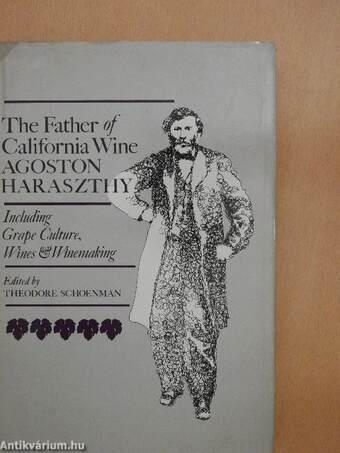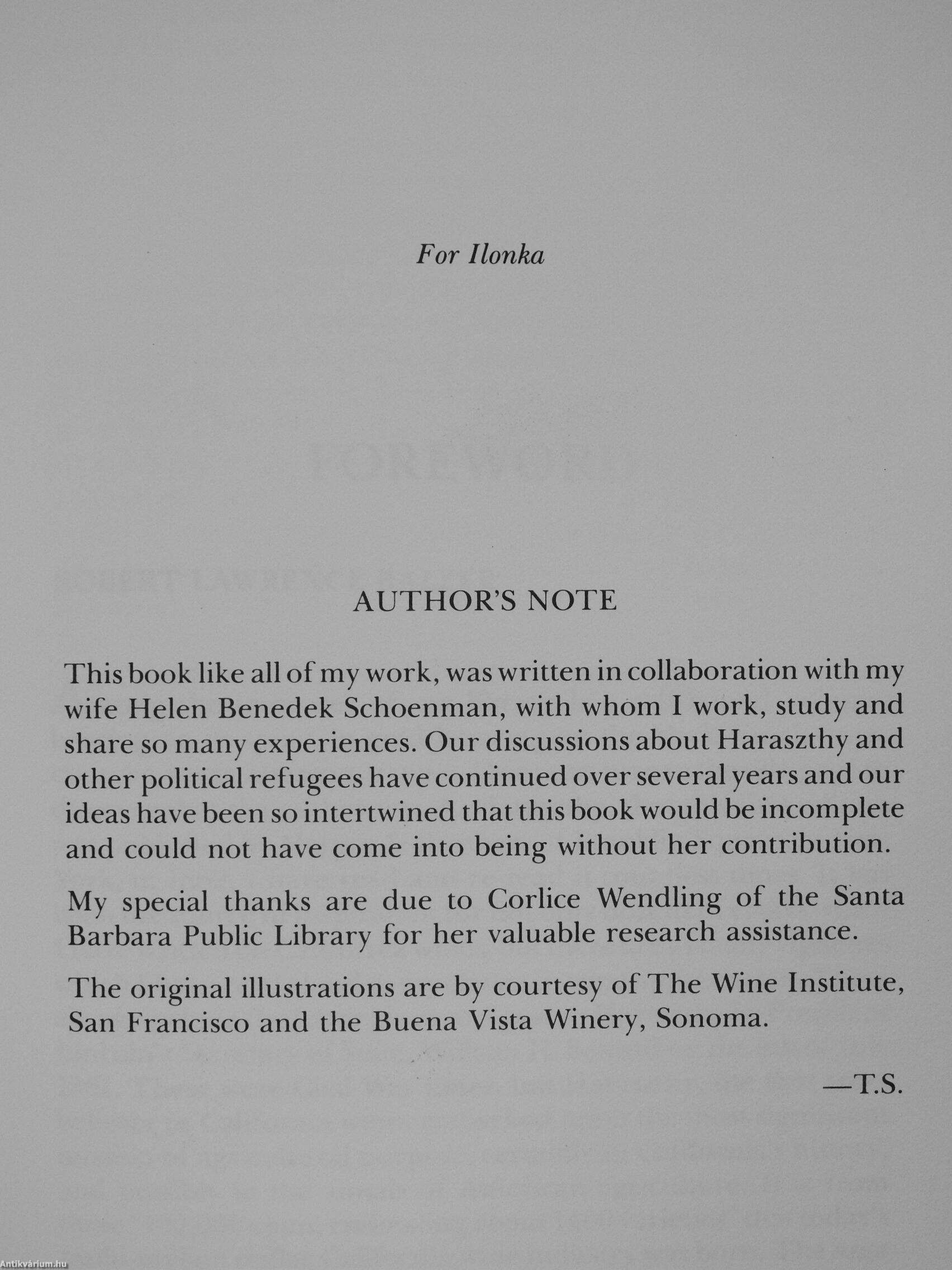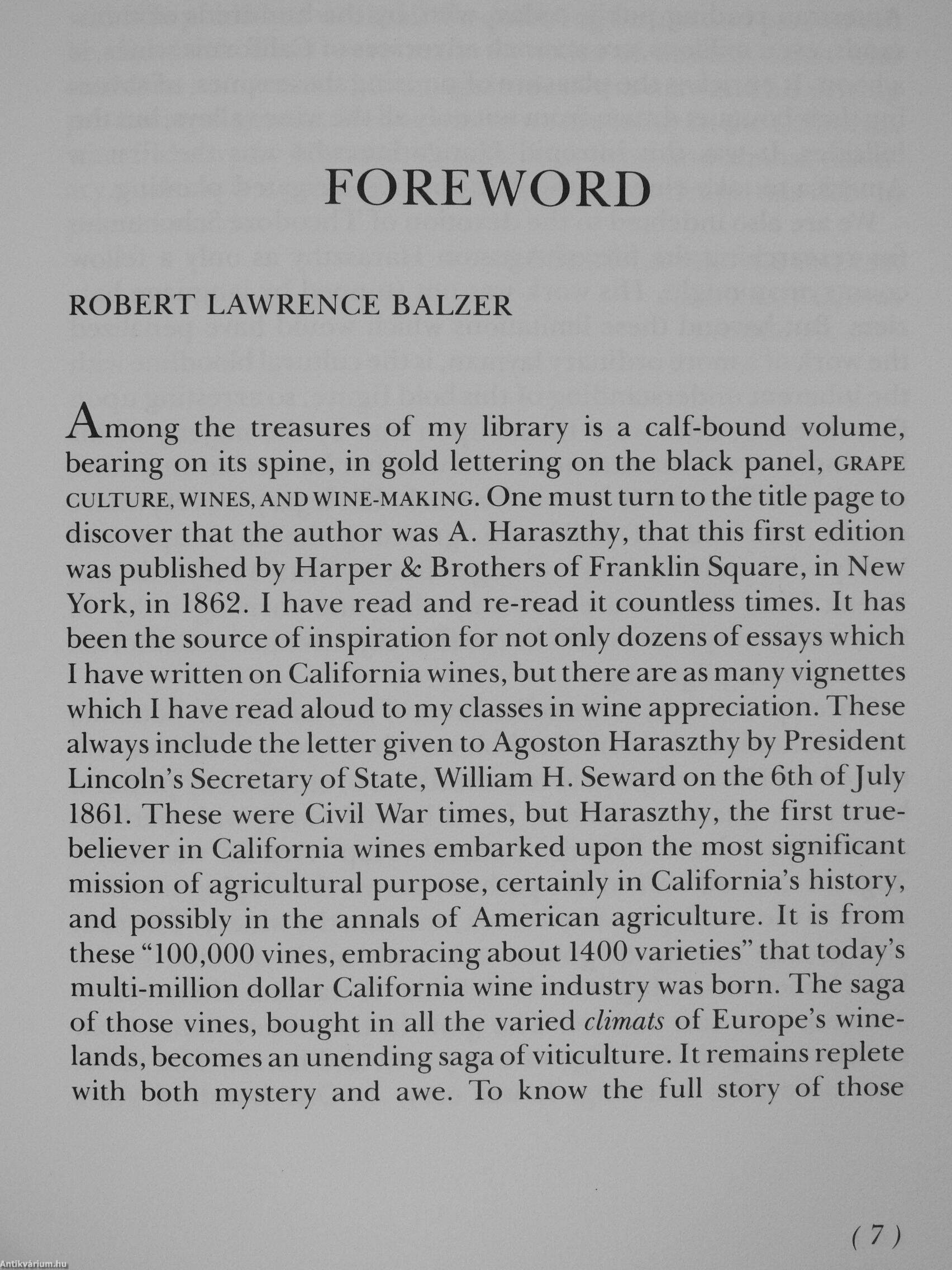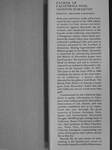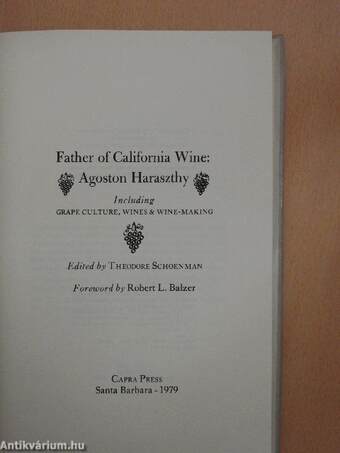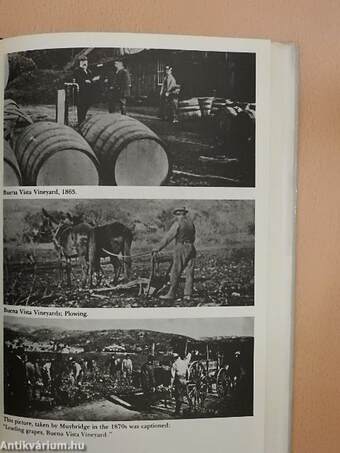1.114.989
kiadvánnyal nyújtjuk Magyarország legnagyobb antikvár könyv-kínálatát
Father of California Wine: Agoston Haraszthy
Including grape culture, wines & wine-making
| Kiadó: | Capra Press |
|---|---|
| Kiadás helye: | Santa Barbara |
| Kiadás éve: | |
| Kötés típusa: | Félvászon |
| Oldalszám: | 126 oldal |
| Sorozatcím: | |
| Kötetszám: | |
| Nyelv: | Angol |
| Méret: | 24 cm x 16 cm |
| ISBN: | 0-88496-092-7 |
| Megjegyzés: | Fekete-fehér fotókkal illusztrálva. |
naponta értesítjük a beérkező friss
kiadványokról
naponta értesítjük a beérkező friss
kiadványokról
Előszó
TovábbFülszöveg
FATHER OF CALIFORNIA WINE: ÁGOSTON HARASZTHY
Edited by THEODORE SCHOENMAN
Both wine and history buffs will be fascinated by this reprint of the 1862 edition of GRAPE CULTURE, WINES AND WINE-MAKING by Ágoston Haraszthy, the adventurer and viticulturist known as the founder of the California wine industry. A Hungarian vintner whose family produced the famed Tokay wine, Haraszthy eschewed a nobleman's hfe and came to America attracted by the freedom of democracy. Having experimented with Mission grapes in San Diego, Haraszthy is renowned for introducing Zinfandel and Muscat of Alexandria grapes near San Francisco. His search for the perfect blend of climate and soil to nurture a vineyard was realized in Haraszthy's discovery of the Sonoma Valley in 1857. The years in his life from 1859 to 1868 constitute the history of the wine industry in California, a history often obscured by the glittery Gold Rush. The Buena Vista Winery in Sonoma County grew from Haraszthy's belief that the... Tovább
Fülszöveg
FATHER OF CALIFORNIA WINE: ÁGOSTON HARASZTHY
Edited by THEODORE SCHOENMAN
Both wine and history buffs will be fascinated by this reprint of the 1862 edition of GRAPE CULTURE, WINES AND WINE-MAKING by Ágoston Haraszthy, the adventurer and viticulturist known as the founder of the California wine industry. A Hungarian vintner whose family produced the famed Tokay wine, Haraszthy eschewed a nobleman's hfe and came to America attracted by the freedom of democracy. Having experimented with Mission grapes in San Diego, Haraszthy is renowned for introducing Zinfandel and Muscat of Alexandria grapes near San Francisco. His search for the perfect blend of climate and soil to nurture a vineyard was realized in Haraszthy's discovery of the Sonoma Valley in 1857. The years in his life from 1859 to 1868 constitute the history of the wine industry in California, a history often obscured by the glittery Gold Rush. The Buena Vista Winery in Sonoma County grew from Haraszthy's belief that the rich California soil was worth more than gold.
Commissioned by the California legislature to gather information on European wine-making methods, Haraszthy's observations of soil, climate, and vine varieties established him as an expert. From this tour through the great wineries of France, Germany, Italy, Spain and Switzerland, Haraszthy brought 100,000 grape cuttings back to California. Buena Vista became California's chief producer of Pinot Chardon-nay, Pinot Noir, Gewurztraminer, Cabernet Sauvignon, representing centuries of European wine culture accessible to this day.
Beyond the art and science of wine-making is the flamboyant career of Haraszthy himself as told by Schoenman,
a fellow Hungarian. Migrating from Hungary in 1840, where he served as private secretary to the viceroy, Haraszthy settled first in Wisconsin. There he founded the settlement that has become Sauk City and planted the state's first hop yard. The Wollersheim Winery is the result of Haraszthy's vineyard experiments in Wisconsin. In 1849, Haraszthy moved to the warmer climate of San Diego, where he was elected county sheriff and a member of the state legislature in 1852. Appointed assayer for the San Francisco Mint, Haraszthy also invented a highly efficient gold-refining process.
Always a pioneer, Haraszthy's thirst for adventure led him to Nicaragua where he acquired 100,000 acres of land and a license to manufacture sugar. He died there in 1869, supposedly eaten by alligators. Ten years ago, DEATH VALLEY DAYS featured an episode on Haraszthy called "The Man Who Planted Gold in California," in reference to his "golden" grape cuttings. The ALTA CALIFORNIA'S 1869 obituary outlined his spectacular life and commented on the "new elements of wealth" introduced to California through his labors, a wealth apparent in what is now a world-wide recognition of California wines. Vissza
Témakörök
Megvásárolható példányok
Nincs megvásárolható példány
A könyv összes megrendelhető példánya elfogyott. Ha kívánja, előjegyezheti a könyvet, és amint a könyv egy újabb példánya elérhető lesz, értesítjük.


